Ánh xạ ẩn dụ ý niệm trong các bài báo kinh tế từ cứ liệu tiếng Anh
Bài viết này với những phân tích về phép ẩn dụ được rút ra từ một số tờ báo kinh tế, góp phần tăng
nhận thức của độc giả về ẩn dụ trong lĩnh vực kinh tế. Thông qua bài viết này, miền khái niệm
trừu tượng “kinh tế” sẽ được ánh xạ lên một miền khác để hiểu được miền khái niệm này theo một
cách mới, cụ thể hơn. Cứ liệu phân tích của bài báo được rút ra từ các mục tài chính và kinh tế
của 15 bài báo về kinh tế nổi tiếng được cập nhật trong năm 2016, 2017. Kết quả nghiên cứu cho
thấy, phép ẩn dụ Kinh tế là một cơ thể sống chiếm phần lớn trong các ẩn dụ được sử dụng trong
cứ liệu. Bên cạnh đó còn có ba ẩn dụ khác phổ biến cũng được tìm thấy trong cứ liệu và được ánh
xạ: Trạng thái của nền kinh tế là một trạng thái vật chất; Trạng thái của nền kinh tế là một trạng
thái tinh thần; Phản ứng của nền kinh tế là một phản ứng của tự nhiên.
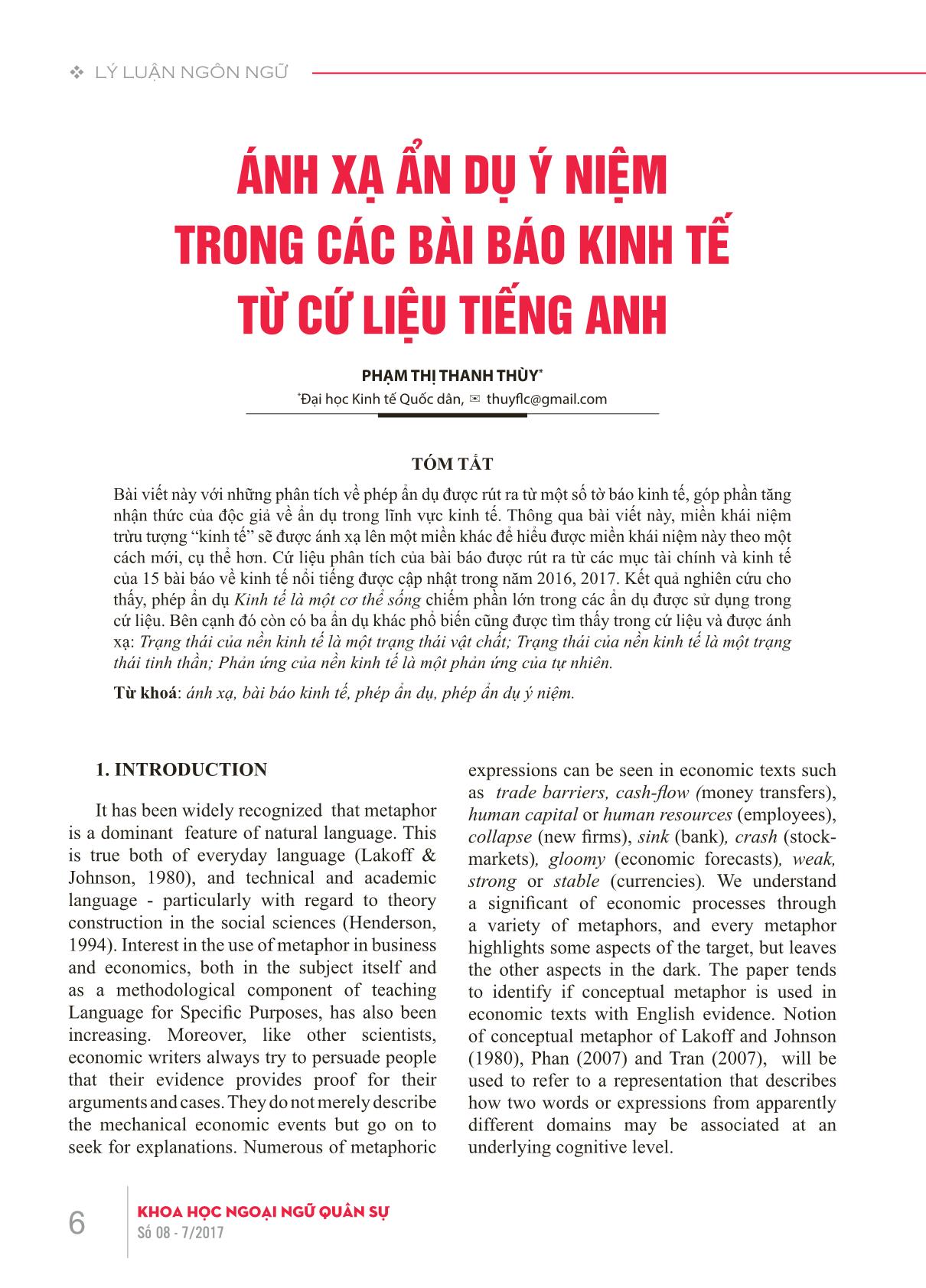
Trang 1
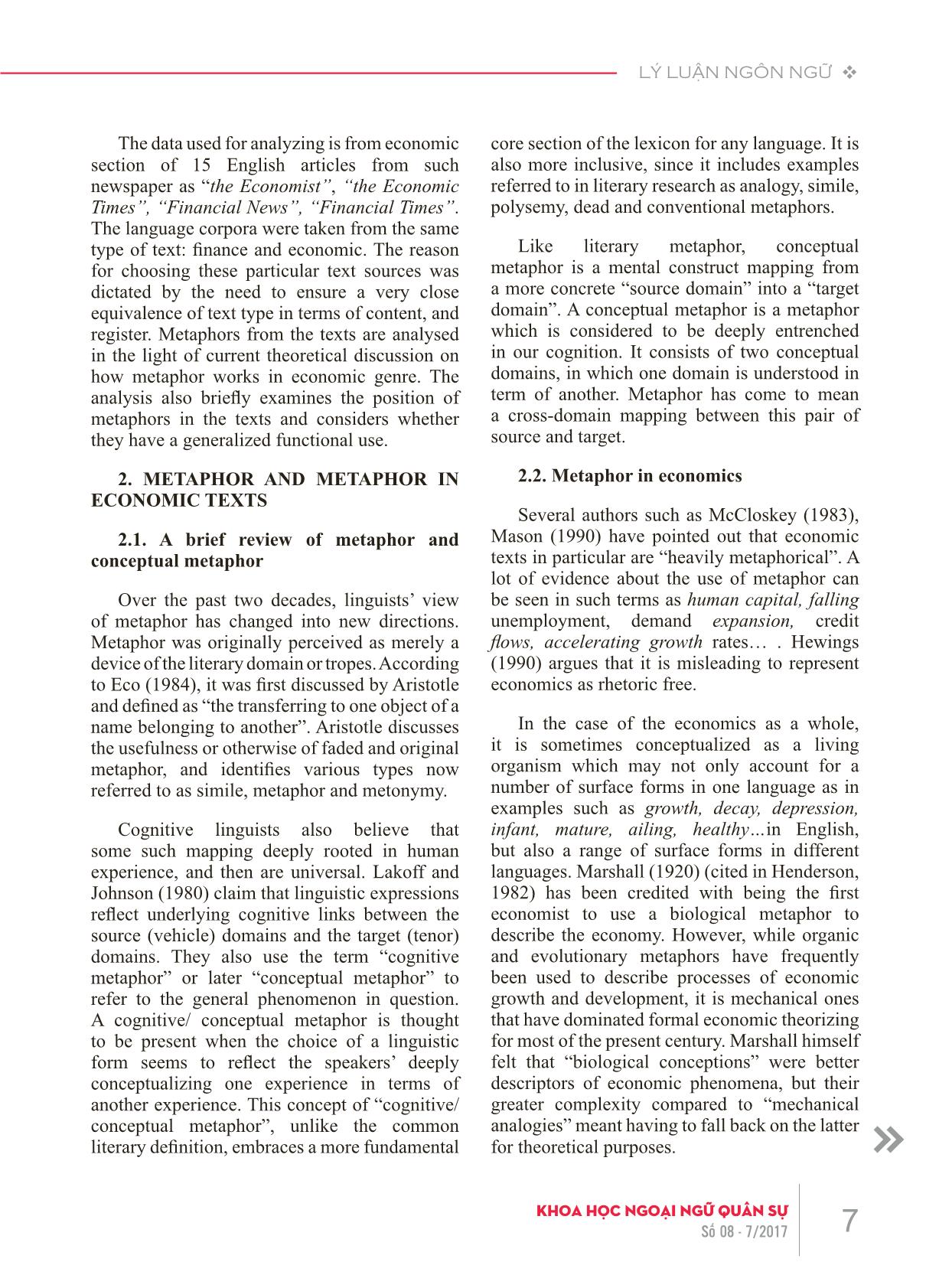
Trang 2

Trang 3
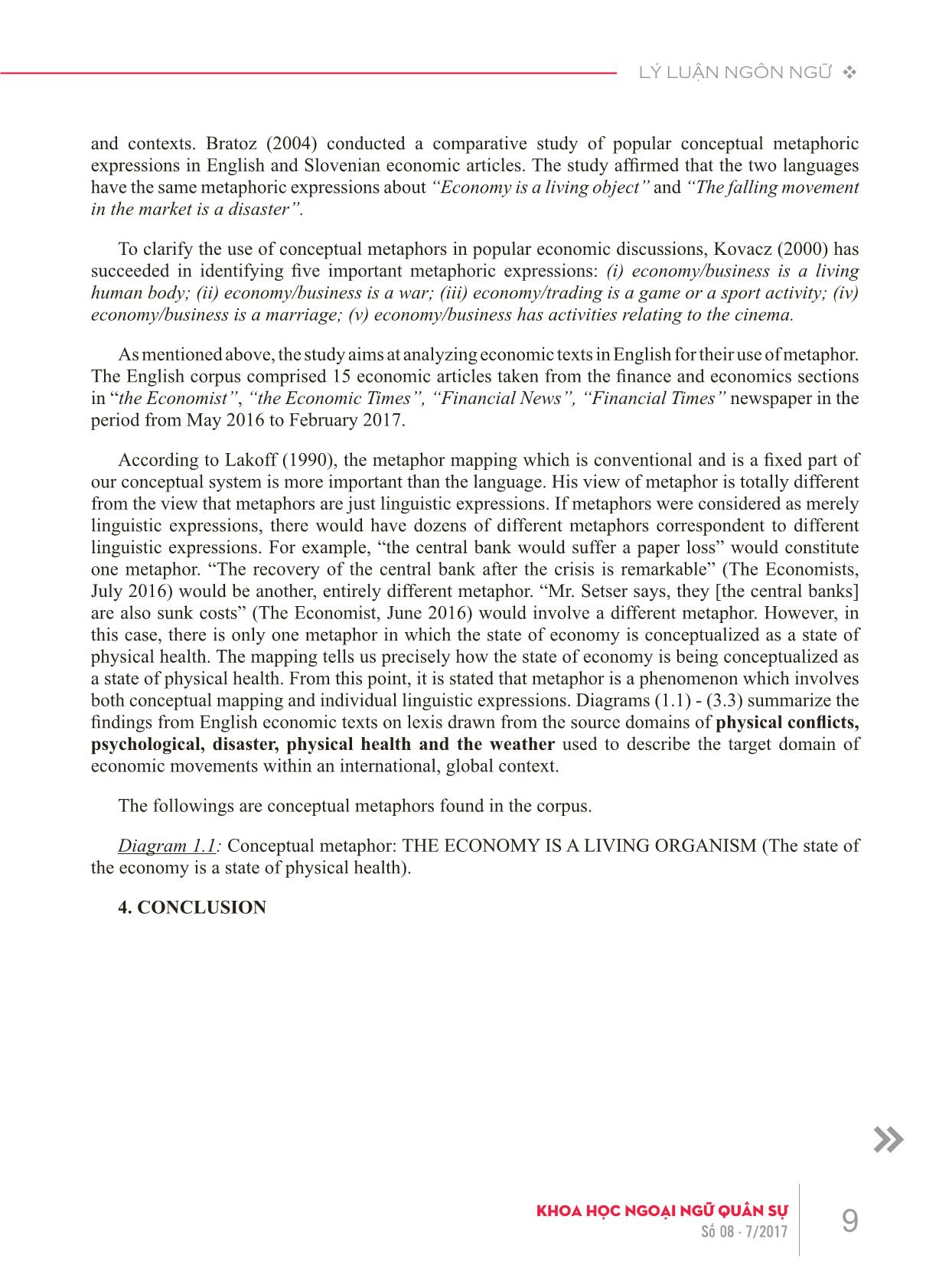
Trang 4
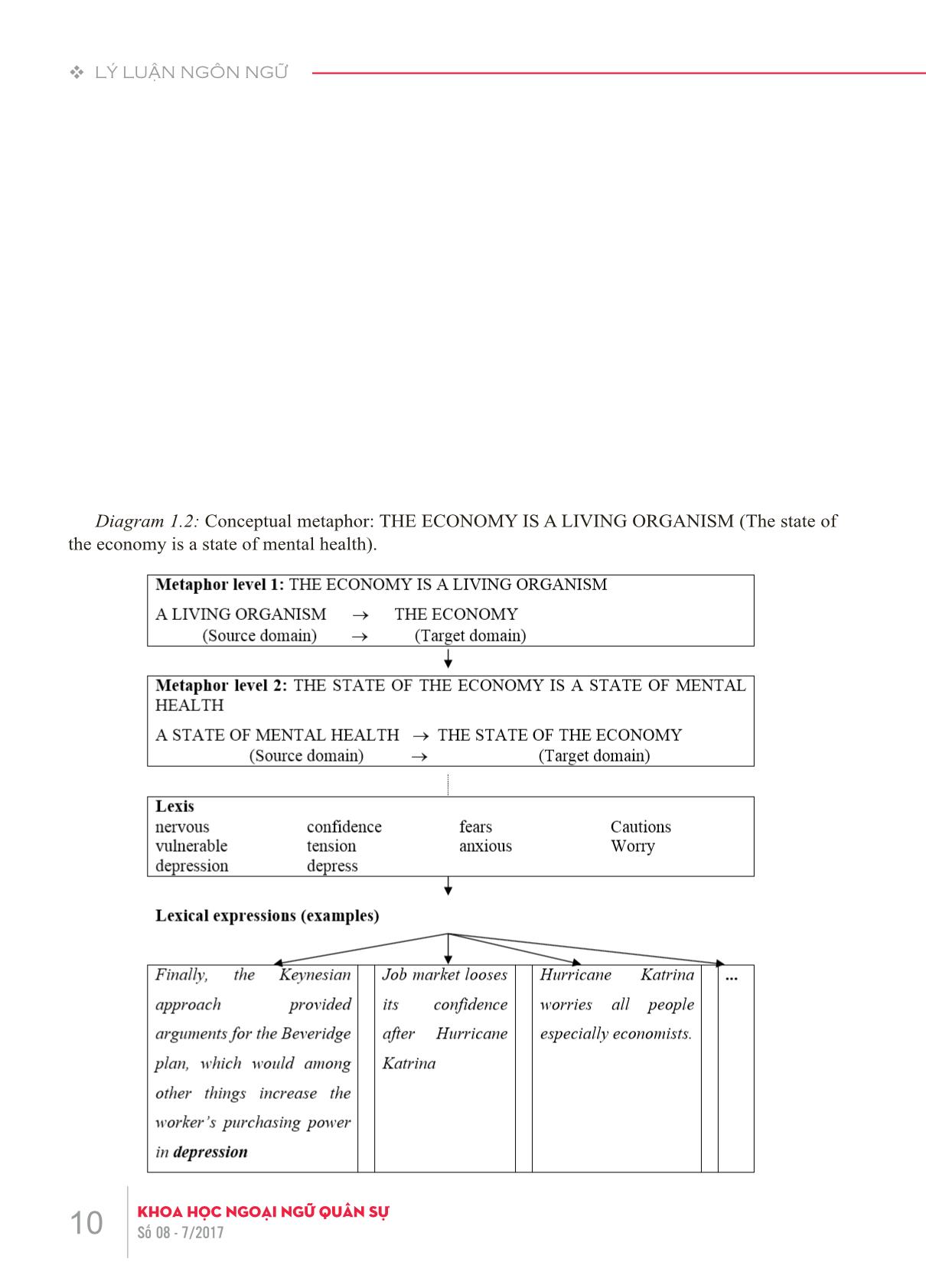
Trang 5
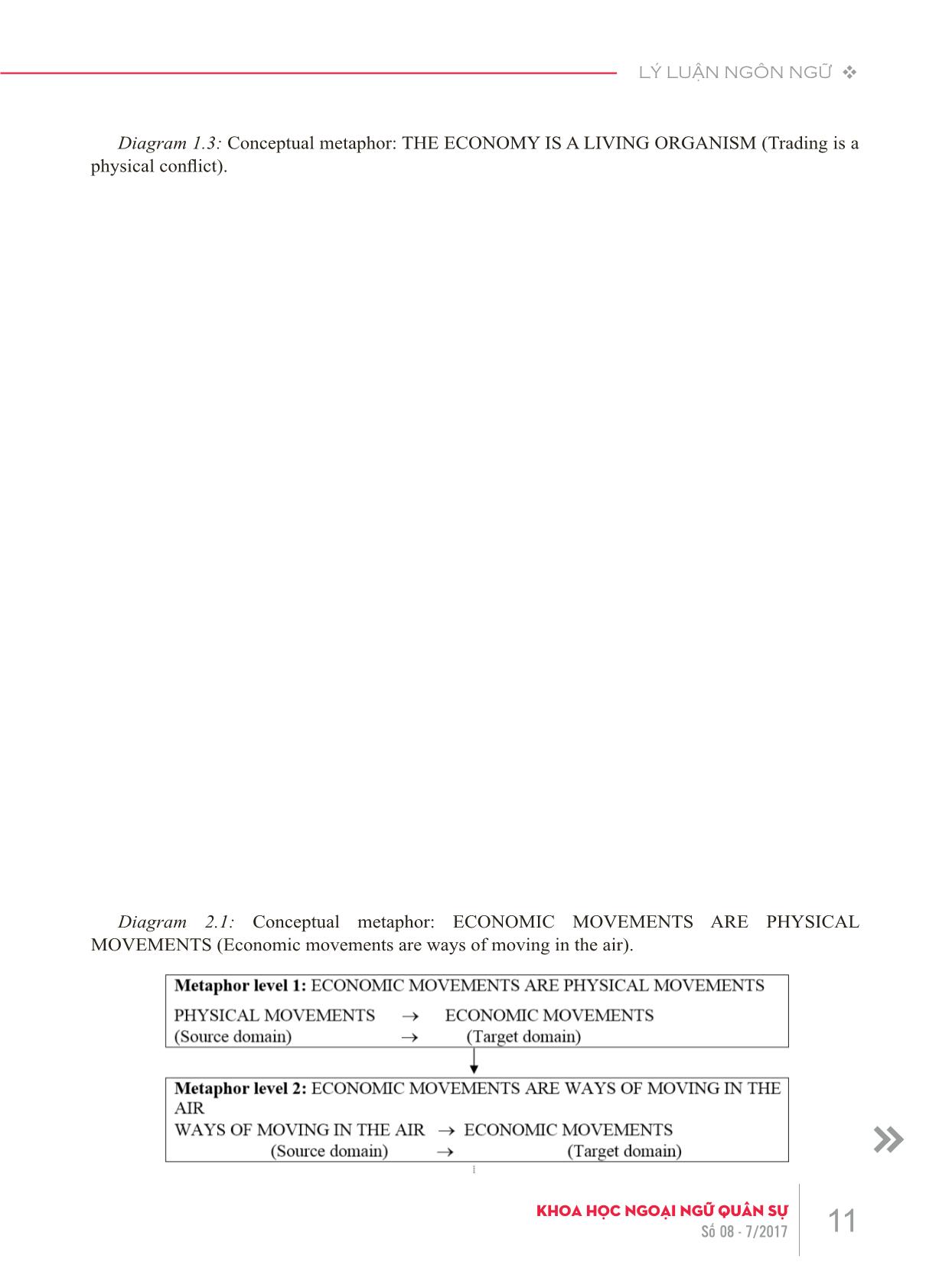
Trang 6
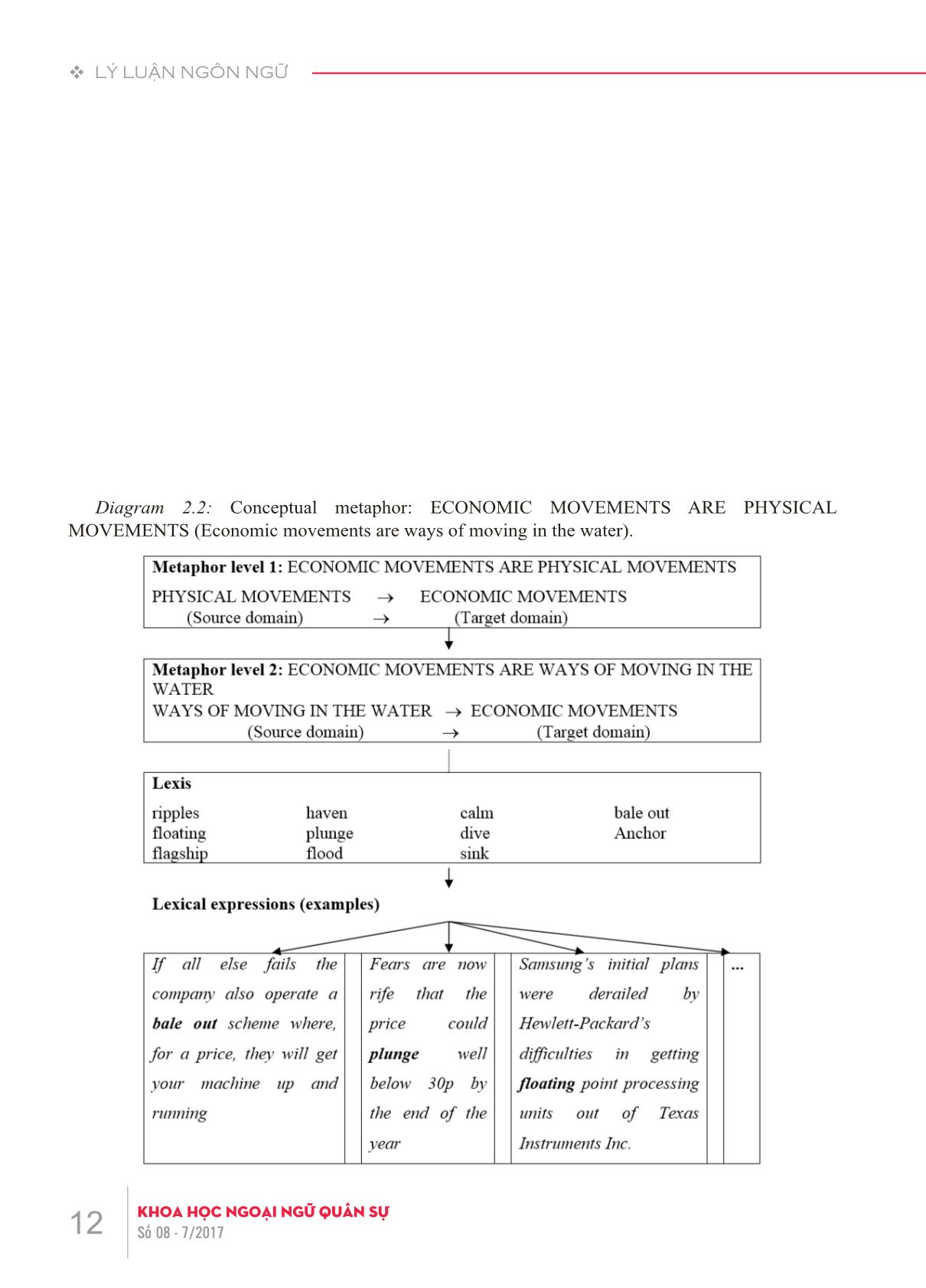
Trang 7
Tóm tắt nội dung tài liệu: Ánh xạ ẩn dụ ý niệm trong các bài báo kinh tế từ cứ liệu tiếng Anh
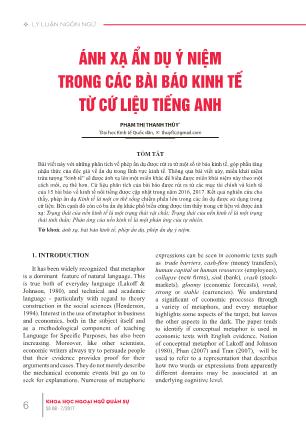
6 KHOA HỌC NGOẠI NGỮ QUÂN SỰSố 08 - 7/2017 v LÝ LUẬN NGÔN NGỮ PHẠM THỊ THANH THÙY* *Đại học Kinh tế Quốc dân, ✉ thuyflc@gmail.com 1. INTRODUCTION It has been widely recognized that metaphor is a dominant feature of natural language. This is true both of everyday language (Lakoff & Johnson, 1980), and technical and academic language - particularly with regard to theory construction in the social sciences (Henderson, 1994). Interest in the use of metaphor in business and economics, both in the subject itself and as a methodological component of teaching Language for Specific Purposes, has also been increasing. Moreover, like other scientists, economic writers always try to persuade people that their evidence provides proof for their arguments and cases. They do not merely describe the mechanical economic events but go on to seek for explanations. Numerous of metaphoric ÁNH XẠ ẨN DỤ Ý NIỆM TRONG CÁC BÀI BÁO KINH TẾ TỪ CỨ LIỆU TIẾNG ANH TÓM TẮT Bài viết này với những phân tích về phép ẩn dụ được rút ra từ một số tờ báo kinh tế, góp phần tăng nhận thức của độc giả về ẩn dụ trong lĩnh vực kinh tế. Thông qua bài viết này, miền khái niệm trừu tượng “kinh tế” sẽ được ánh xạ lên một miền khác để hiểu được miền khái niệm này theo một cách mới, cụ thể hơn. Cứ liệu phân tích của bài báo được rút ra từ các mục tài chính và kinh tế của 15 bài báo về kinh tế nổi tiếng được cập nhật trong năm 2016, 2017. Kết quả nghiên cứu cho thấy, phép ẩn dụ Kinh tế là một cơ thể sống chiếm phần lớn trong các ẩn dụ được sử dụng trong cứ liệu. Bên cạnh đó còn có ba ẩn dụ khác phổ biến cũng được tìm thấy trong cứ liệu và được ánh xạ: Trạng thái của nền kinh tế là một trạng thái vật chất; Trạng thái của nền kinh tế là một trạng thái tinh thần; Phản ứng của nền kinh tế là một phản ứng của tự nhiên. Từ khoá: ánh xạ, bài báo kinh tế, phép ẩn dụ, phép ẩn dụ ý niệm. expressions can be seen in economic texts such as trade barriers, cash-flow (money transfers), human capital or human resources (employees), collapse (new firms), sink (bank), crash (stock- markets), gloomy (economic forecasts), weak, strong or stable (currencies). We understand a significant of economic processes through a variety of metaphors, and every metaphor highlights some aspects of the target, but leaves the other aspects in the dark. The paper tends to identify if conceptual metaphor is used in economic texts with English evidence. Notion of conceptual metaphor of Lakoff and Johnson (1980), Phan (2007) and Tran (2007), will be used to refer to a representation that describes how two words or expressions from apparently different domains may be associated at an underlying cognitive level. 7KHOA HỌC NGOẠI NGỮ QUÂN SỰSố 08 - 7/2017 LÝ LUẬN NGÔN NGỮ v The data used for analyzing is from economic section of 15 English articles from such newspaper as “the Economist”, “the Economic Times”, “Financial News”, “Financial Times”. The language corpora were taken from the same type of text: finance and economic. The reason for choosing these particular text sources was dictated by the need to ensure a very close equivalence of text type in terms of content, and register. Metaphors from the texts are analysed in the light of current theoretical discussion on how metaphor works in economic genre. The analysis also briefly examines the position of metaphors in the texts and considers whether they have a generalized functional use. 2. METAPHOR AND METAPHOR IN ECONOMIC TEXTS 2.1. A brief review of metaphor and conceptual metaphor Over the past two decades, linguists’ view of metaphor has changed into new directions. Metaphor was originally perceived as merely a device of the literary domain or tropes. According to Eco (1984), it was first discussed by Aristotle and defined as “the transferring to one object of a name belonging to another”. Aristotle discusses the usefulness or otherwise of faded and original metaphor, and identifies various types now referred to as simile, metaphor and metonymy. Cognitive linguists also believe that some such mapping deeply rooted in human experience, and then are universal. Lakoff and Johnson (1980) claim that linguistic expressions reflect underlying cognitive links between the source (vehicle) domains and the target (tenor) domains. They also use the term “cognitive metaphor” or later “conceptual metaphor” to refer to the general phenomenon in question. A cognitive/ conceptual metaphor is thought to be present when the choice of a linguistic form seems to reflect the speakers’ deeply conceptualizing one experience in terms of another experience. This concept of “cognitive/ conceptual metaphor”, unlike the common literary definition, embraces a more fundamental core section of the lexicon for any language. It is also more inclusive, since it includes examples referred to in literary research as analogy, simile, polysemy, dead and conventional metaphors. Like literary metaphor, conceptual metaphor is a mental construct mapping from a more concrete “source domain” into a “target domain”. A conceptual metaphor is a metaphor which is considered to be deeply entrenched in our cognition. It consists of two conceptual domains, in which one domain is understood in term of another. Metaphor has come to mean a cross-domain mapping between this pair of source and target. 2.2. Metaphor in economics Several authors such as McCloskey (1983), Mason (1990) have pointed out that economic texts in particular are “heavily metaphorical”. A lot of evidence about the use of metaphor can be seen in such terms as human capital, falling unemployment, demand expansion, credit flows, accelerating growth rates . Hewings (1990) argues that it is misleading to represent economics as rhetoric free. In the case of the economics as a whole, it is sometimes conceptualized as a living organism which may not only account for a number of surface forms in one language as in examples such as growth, decay, depression, infant, mature, ailing, healthyin English, but also a range of surface forms in different languages. Marshall (1920) (cited in Henderson, 1982) has been credited with being the first economist to use a biological metaphor to describe the economy. However, while organic and evolutionary metaphors have frequently been used to describe processes of economic growth and development, it is mechanical ones that have dominated formal economic theorizing for most of the present century. Marshall himself felt that “biological conceptions” were better descriptors of economic phenomena, but their greater complexity compared to “mechanical analogies” meant having to fall back on the latter for theoretical purposes. 8 KHOA HỌC NGOẠI NGỮ QUÂN SỰSố 08 - 7/2017 v LÝ LUẬN NGÔN NGỮ Previously Huynh Ngoc Mai Kha (2014) conducted a research on metaphors in economic newspapers in Vietnam. The research “focuses on understanding some metaphorical expressions in Vietnamese economic newspapers”, but this research has not yet delineated the specific mechanism of mapping in the ideological structures. 3. MAPPING CONCEPTUAL METAPHOR IN ECONOMIC TEXTS The notion of conceptual metaphoric appeared when metaphor was studied in a new trend on the basis of cognitive linguistics, which describes how people understand abstract concepts when they are visualized through human emotional experiences (Phan The Hung (2007). According to Tran Van Co (2007), the system of conceptual metaphors is created in a natural, unconscious and understandable way and does not require much effort to understand them as previously. Nguyen Duc Ton (2007) also agrees with the view that the core of metaphor is a thought, not language, and he explains further that in the process of, human beings have assimilated the notion of certain things whose characteristics are similar. As the result, people use the same name to call similar things (this is called the lexical metaphor) and gradually, in the process of creating new understanding, human beings continue to transform the characteristics and phenomena of these things into characteristics, phenomena of other things (this is called conceptual metaphor) when their thoughts identify them similarly. In other words, conceptual metaphors reflect human thinking about global. To understand more about conceptual metaphors, we can take a very common metaphor in business to illustrate this point: Trading is a battlefield. In this metaphor, the source domain is “battlefield”, and the target domain is “business”. In this mapping, “business” - the target domain, an abstract concept- is specified by a more specific source domain - the battlefield. From this mapping, an abstract concept “business” is understood clearly through a specific domain “battlefield”. The concept “business” is understood through the concept “battlefield” because these two concepts have a lot of similarities which are outlined in the following table: Table 1: The similarities between the “battlefield” domain and the “business” domain. Criteria to compare Battlefield (source domain) Business (target domain) Object: soldiers whose main duty is fighting Businessmen whose job is doing business Means: Weapons: guns, ammunition, tactics, skills, sensitivity to the enemy Investment strategies, business ideas, sensitivity to competitors, products, advertising . Purposes: Reach the final goal: win the opponents Achieve more profitable, sustainable, and stable business Drawbacks: Being caught, lost, fired up ... Failed, fail business strategy, lost money, go bankrupt. Solutions: Negotiating, fighting to the end, surrendering, ending the war. Cooperating, using new business strategies, avoiding confrontation ... From Table 1 above, we see some actions and states of the source domain are mapped to the respective aspects of the target domain. In the economic field and in economic articles, studying about conceptual metaphors is not a new trend. Many researchers have done their research about conceptual metaphors in different languages 9KHOA HỌC NGOẠI NGỮ QUÂN SỰSố 08 - 7/2017 LÝ LUẬN NGÔN NGỮ v and contexts. Bratoz (2004) conducted a comparative study of popular conceptual metaphoric expressions in English and Slovenian economic articles. The study affirmed that the two languages have the same metaphoric expressions about “Economy is a living object” and “The falling movement in the market is a disaster”. To clarify the use of conceptual metaphors in popular economic discussions, Kovacz (2000) has succeeded in identifying five important metaphoric expressions: (i) economy/business is a living human body; (ii) economy/business is a war; (iii) economy/trading is a game or a sport activity; (iv) economy/business is a marriage; (v) economy/business has activities relating to the cinema. As mentioned above, the study aims at analyzing economic texts in English for their use of metaphor. The English corpus comprised 15 economic articles taken from the finance and economics sections in “the Economist”, “the Economic Times”, “Financial News”, “Financial Times” newspaper in the period from May 2016 to February 2017. According to Lakoff (1990), the metaphor mapping which is conventional and is a fixed part of our conceptual system is more important than the language. His view of metaphor is totally different from the view that metaphors are just linguistic expressions. If metaphors were considered as merely linguistic expressions, there would have dozens of different metaphors correspondent to different linguistic expressions. For example, “the central bank would suffer a paper loss” would constitute one metaphor. “The recovery of the central bank after the crisis is remarkable” (The Economists, July 2016) would be another, entirely different metaphor. “Mr. Setser says, they [the central banks] are also sunk costs” (The Economist, June 2016) would involve a different metaphor. However, in this case, there is only one metaphor in which the state of economy is conceptualized as a state of physical health. The mapping tells us precisely how the state of economy is being conceptualized as a state of physical health. From this point, it is stated that metaphor is a phenomenon which involves both conceptual mapping and individual linguistic expressions. Diagrams (1.1) - (3.3) summarize the findings from English economic texts on lexis drawn from the source domains of physical conflicts, psychological, disaster, physical health and the weather used to describe the target domain of economic movements within an international, global context. The followings are conceptual metaphors found in the corpus. Diagram 1.1: Conceptual metaphor: THE ECONOMY IS A LIVING ORGANISM (The state of the economy is a state of physical health). 4. CONCLUSION 10 KHOA HỌC NGOẠI NGỮ QUÂN SỰSố 08 - 7/2017 v LÝ LUẬN NGÔN NGỮ Diagram 1.2: Conceptual metaphor: THE ECONOMY IS A LIVING ORGANISM (The state of the economy is a state of mental health). 11KHOA HỌC NGOẠI NGỮ QUÂN SỰSố 08 - 7/2017 LÝ LUẬN NGÔN NGỮ v Diagram 1.3: Conceptual metaphor: THE ECONOMY IS A LIVING ORGANISM (Trading is a physical conflict). Diagram 2.1: Conceptual metaphor: ECONOMIC MOVEMENTS ARE PHYSICAL MOVEMENTS (Economic movements are ways of moving in the air). 12 KHOA HỌC NGOẠI NGỮ QUÂN SỰSố 08 - 7/2017 v LÝ LUẬN NGÔN NGỮ Diagram 2.2: Conceptual metaphor: ECONOMIC MOVEMENTS ARE PHYSICAL MOVEMENTS (Economic movements are ways of moving in the water).
File đính kèm:
 anh_xa_an_du_y_niem_trong_cac_bai_bao_kinh_te_tu_cu_lieu_tie.pdf
anh_xa_an_du_y_niem_trong_cac_bai_bao_kinh_te_tu_cu_lieu_tie.pdf

